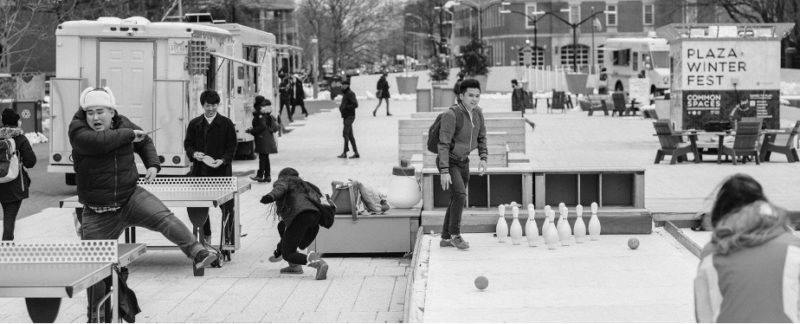
Land Connections–The Seven Tenets of Resilient Spaces


The measure of any great civilization is in its cities, and the measure of a city’s greatness is to be found in the quality of its public spaces, its parks and squares.
John Ruskin
Yesterday and Today
There has been much uncertainty over the past two years and if that period has taught us anything, it’s that you can’t predict the future. COVID-19 arrived quickly and has lingered on stubbornly. In this era of variants and endemicity, the “new normal” so many people anticipated might never truly “normalize.” Urban public spaces are one of the few gathering places where many groups of people continue to feel safe. Many have fewer restrictions than indoor spaces and a result, have taken on a new primacy of public function. With this increased usage, their importance can’t be understated; our revitalized public spaces must be designed to be adaptable to how people want to use them from moment to moment, and year to year.
However, looking back, it was not always that way. While true that public spaces had long been the basis for expression of cultural values and historically, squares and streets had a dynamism and richness to them (attributed to the myriad of activities that used to occur at the time like trading, socializing, standing, sitting etc.), the design of public spaces in the second half of the 20th century morphed to one that was more static, focused mainly on pragmatism, functionality, and efficiency. This frequently led to unprogrammed (or poorly programmed) vast spaces with minimal possibilities for simple communication and interactions. The journalist and author Jane Jacobs refers to this period as the “crisis of planning” as top-down planning tools at the time didn’t give enough flexibility to respond to urban and social changes.
Slowly, there was an awakening that the resilience of public spaces wasn’t only about a matter of the physical setting, but rather making an effort to understand the behavioral setting and attempting to answer the question: What makes people feel good about where they live, work or play? Is there a way to take a people-centered approach in the planning, design, and management of public spaces? This eventually led to many existing urban spaces being re-envisioned and rediscovered as places of cultural and social vitality.
It also dawned on designers that users of a space are incredibly inventive when given the opportunity or the prompt. As a young impressionable student at the Harvard Graduate School of Design several years ago, I was struck by the nature of one of the important public spaces on campus –Harvard Plaza. Reading more about its history brought to light the fact that this was not too long ago a space rendered lifeless by a lack of accommodation for anything but people passing through. In contrast, the new space today plays on people’s inexhaustible craving for discovery, for a variety of physical and sensorial experiences, for social interaction of many sorts; being flexible and set up—equipped—to be programmed and re-programmed easily.

Below are seven tenets to keep in mind when tasked with envisioning truly resilient spaces:
1. Consider Ideas Which Can Be Seamlessly Repurposed
During the conceptual design process, consider ideas that can be seamlessly repurposed into settings for something entirely different (play spaces potentially doubling as outdoor classrooms, plazas, and parking lots becoming spaces for community events, performances, gatherings, etc.), considering maximizing the possibility of interactions and synergies between different functions and user groups.
Much playground design recently has morphed from prescribed activities on single-use pieces of equipment to more exploratory and open-ended play environments that encourage improvisation and free, creative play.

2. Predict Behavioral Patterns
Predicting the possibility of various behavioral patterns is another important aspect of designing flexible and adaptable spaces. An example would be anticipating desired lines of pedestrian movement through a public space and providing opportunities for pausing/sitting/waiting along that route. It might mean widening an existing wall to act as a seat wall or creating a ledge on an existing building wall for waiting and sitting.

3. Engage a Diversity of Uses
Consider ideas that allow for a diversity of programming to foster interaction opportunities. As an example, the seemingly contradictory uses of active recreation, areas for pause and contemplation, and social gathering zones all work really well together in park planning and design. If the project brief allows, consider spaces for programming events at different scales to attract diverse users (how events such as food festivals, markets, games, movies, concerts, art shows, and/or sports, etc. can be accommodated simultaneously when desired).



4. Keep the Human Scale in Mind
Nowadays, designers and urban planners are increasingly considering human-related aspects of public spaces more than ever before, and rightly so. A successful social space must have a human scale in order to be a platform for a variety of experiences, behaviors, and activities.
To use Harvard Plaza as an example again, these same principles of diversity, flexibility, and adaptability that inform the space as a whole are also addressed at the scale of the human body in the carefully positioned dual seating elements. These custom-designed wood benches are shaped to accommodate different bodies in different ways and give options for how people choose to sit—cross-legged, upright, slouchy, lounging—alone or in groups, on laps, cuddling, outright lying down, or if you’re a kid: active play.


5. Increase Permeability of the Space
Successful public spaces are connected to their surrounding neighborhoods. To the extent possible, look into maximizing public access during all times of the day and year and paying attention to aspects like access routes, visibility, and permeability of a space (and increasing them as much as possible to make a space feel welcoming). The goal should be to prioritize the pedestrian experience: the arrival, the navigation of the space, the selection of different clusters of activities and destinations, and then departure. These are all important, but often overlooked criteria when designing a flexible space.
6. Consider Informal, Ad Hoc Spaces
Research from students in educational institutions has highlighted that meaningful learning occurs in both formal and informal settings: in fact, active learning occurred more often for students away from the classroom, and often in informal, ad hoc spaces. Research has also revealed that students increasingly seek out flexible learning spaces that are able to adapt to both individual and collaborative work.

7. Give Preference to Multi-Use Spaces
As opposed to specialized spaces, consider multi-use spaces, play fields, and courts. Potentially consider movable seating to allow flexibility in accommodating different spatial configurations and numbers of users.

Conclusion
I would argue that a mindset that allows for flexibility, adaptability, and open-endedness, allowing for various intensities of use and activity to be played out across daily, seasonal, and annual cycles is worth considering. Despite the challenges, it is indeed possible to re-stitch our fragmented urban environments by creating resilient social spaces in the public realm that are built to morph by providing ample opportunities for a space to be explored and lived on its own terms. This I would contend, infuses public space with meaning, vitality, and ultimately—longevity.
References
- Harvard Plaza black and white image; source www.stoss.net
- High Line Park, New York, NY, ASLA
- Downtown East Commons, Minneapolis, MN; source Hargreaves Associates
- White Flint Placemaking Festival; source M-NCPPC
- Harvard Plaza, custom seating elements; source www.stoss.net
About the Author

Samir Khanna, PLA, LEED AP, RQP is a Senior Landscape Architect at O’Dell Engineering’s Pleasanton office. He has over 22 years of experience in the industry and holds a Master of Landscape Architecture from Harvard University. He advocates for an integrated and informed approach to planning and design through ideas that expand upon the notion of overlapping context, landscape, infrastructure, and architecture.
Learn More
For previous Land Connections articles, click here.
For information on joining the O’Dell Engineering team, click here.
To see our landscape architecture project experience, click here.
Go Back